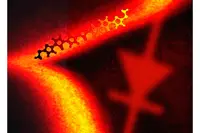 Researchers at Columbia University in New York say they have developed a technique that allows the creation of a single molecule diode. The team adds that its molecular diodes perform 50 times better than all prior designs.
Researchers at Columbia University in New York say they have developed a technique that allows the creation of a single molecule diode. The team adds that its molecular diodes perform 50 times better than all prior designs.
Researchers at Columbia University in New York say they have developed a technique that allows the creation of a single molecule diode. The team adds that its molecular diodes perform 50 times better than all prior designs.
Latha Venkataraman, associate professor of applied physics, who directed the work, said: "Our approach created a single molecule diode that has high rectification (more than 250) and an 'on' current of about 0.1µA. Constructing a device where the active elements are only a single molecule has long been a tantalising dream in nanoscience."
Since a diode acts as a valve, its structure needs to be asymmetric so that electricity flowing in one direction experiences a different environment than electricity flowing in the other direction. To achieve this, the team has designed molecules with asymmetric structures.
"While such asymmetric molecules display some diode like properties, they are not effective," explains Brian Capozzi, a PhD student working with Venkataraman. "A well designed diode should only allow current to flow in the 'on' direction and it should allow a lot of current to flow in that direction. Asymmetric molecular designs have typically suffered from very low current flow in both directions and the ratio of current flow in the two has typically been low."
To overcome these issues, Venkataraman's team focused on developing an asymmetry around the molecular junction by surrounding the active molecule with an ionic solution. They also used gold metal electrodes of different sizes to contact the molecule.
"It's amazing to design a molecular circuit, using concepts from chemistry and physics, and have it do something functional," Venkataraman said. "The length scale is so small that quantum mechanical effects are absolutely a crucial aspect of the device. So it is a triumph to be able to create something that you will never be able to physically see and that behaves as intended."
Venkataraman and her team are now working to understand the fundamental physics behind their discovery and to increase the rectification ratios using new molecular systems.
Author
Graham Pitcher
Source: www.newelectronics.co.uk

